seats FORD E250 2011 Owners Manual
[x] Cancel search | Manufacturer: FORD, Model Year: 2011, Model line: E250, Model: FORD E250 2011Pages: 339, PDF Size: 2.29 MB
Page 6 of 339
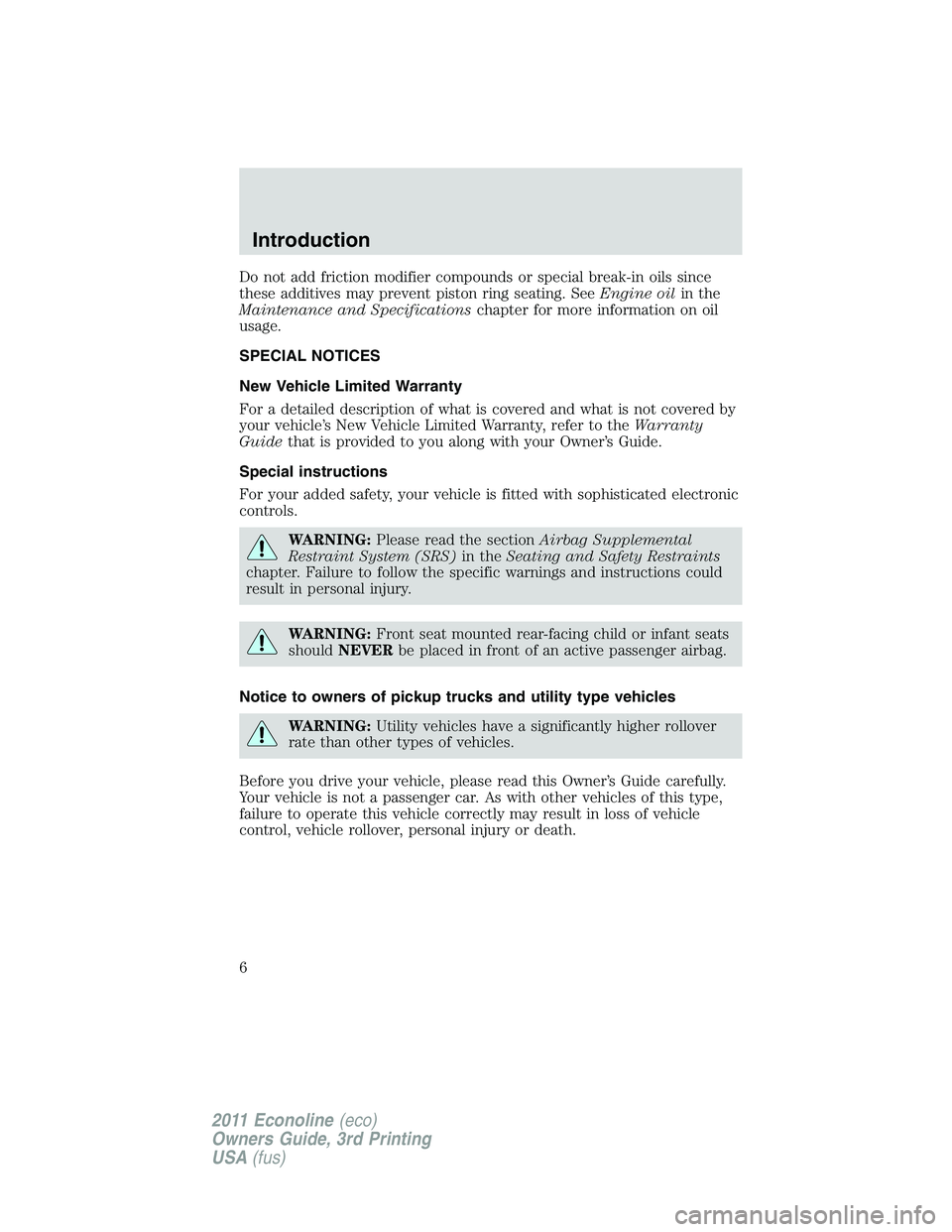
Do not add friction modifier compounds or special break-in oils since
these additives may prevent piston ring seating. SeeEngine oilin the
Maintenance and Specificationschapter for more information on oil
usage.
SPECIAL NOTICES
New Vehicle Limited Warranty
For a detailed description of what is covered and what is not covered by
your vehicle’s New Vehicle Limited Warranty, refer to theWarranty
Guidethat is provided to you along with your Owner’s Guide.
Special instructions
For your added safety, your vehicle is fitted with sophisticated electronic
controls.
WARNING:Please read the sectionAirbag Supplemental
Restraint System (SRS)in theSeating and Safety Restraints
chapter. Failure to follow the specific warnings and instructions could
result in personal injury.
WARNING:Front seat mounted rear-facing child or infant seats
shouldNEVERbe placed in front of an active passenger airbag.
Notice to owners of pickup trucks and utility type vehicles
WARNING:Utility vehicles have a significantly higher rollover
rate than other types of vehicles.
Before you drive your vehicle, please read this Owner’s Guide carefully.
Your vehicle is not a passenger car. As with other vehicles of this type,
failure to operate this vehicle correctly may result in loss of vehicle
control, vehicle rollover, personal injury or death.
Introduction
6
2011 Econoline(eco)
Owners Guide, 3rd Printing
USA(fus)
Page 48 of 339
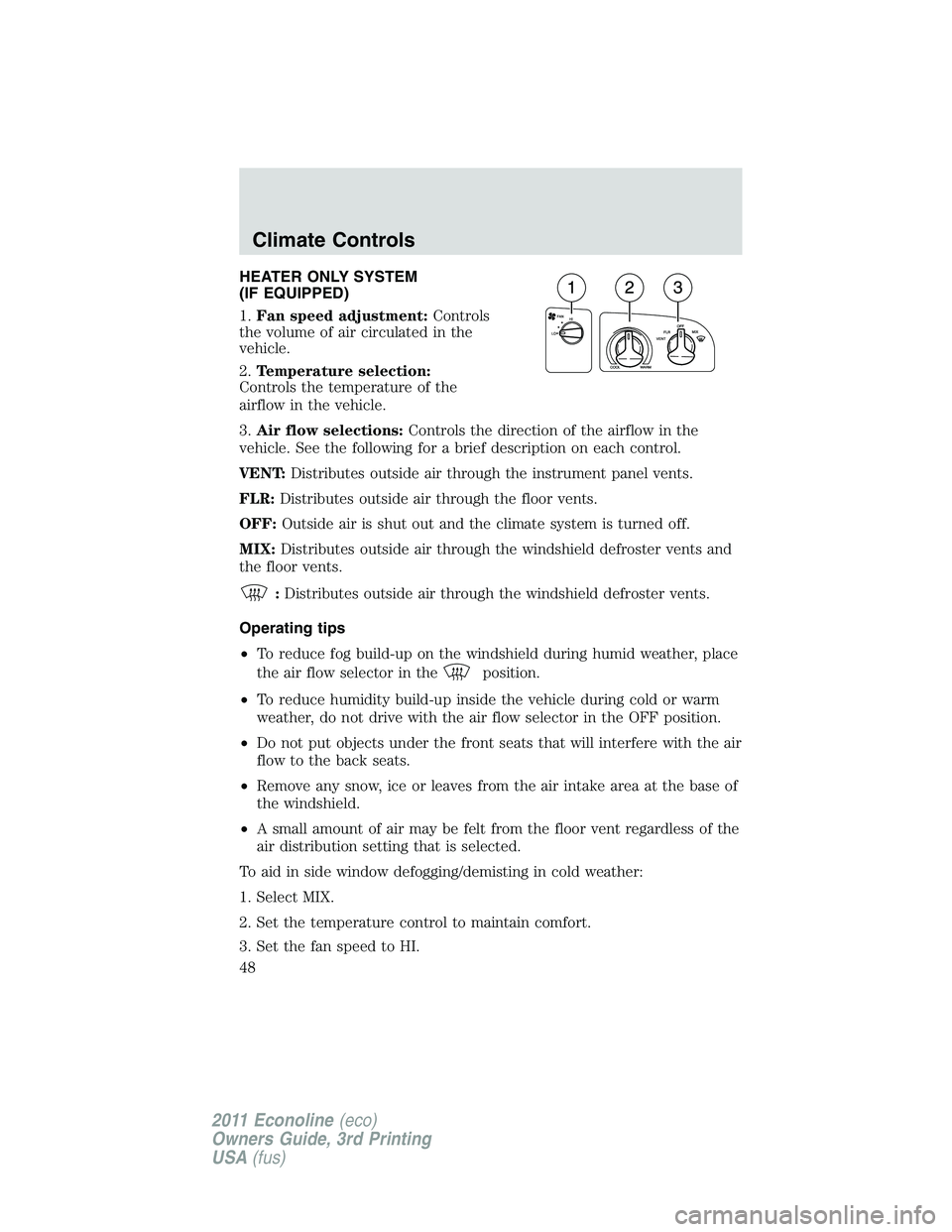
HEATER ONLY SYSTEM
(IF EQUIPPED)
1.Fan speed adjustment:Controls
the volume of air circulated in the
vehicle.
2.Temperature selection:
Controls the temperature of the
airflow in the vehicle.
3.Air flow selections:Controls the direction of the airflow in the
vehicle. See the following for a brief description on each control.
VENT:Distributes outside air through the instrument panel vents.
FLR:Distributes outside air through the floor vents.
OFF:Outside air is shut out and the climate system is turned off.
MIX:Distributes outside air through the windshield defroster vents and
the floor vents.
:Distributes outside air through the windshield defroster vents.
Operating tips
•To reduce fog build-up on the windshield during humid weather, place
the air flow selector in the
position.
•To reduce humidity build-up inside the vehicle during cold or warm
weather, do not drive with the air flow selector in the OFF position.
•Do not put objects under the front seats that will interfere with the air
flow to the back seats.
•Remove any snow, ice or leaves from the air intake area at the base of
the windshield.
•A small amount of air may be felt from the floor vent regardless of the
air distribution setting that is selected.
To aid in side window defogging/demisting in cold weather:
1. Select MIX.
2. Set the temperature control to maintain comfort.
3. Set the fan speed to HI.
Climate Controls
48
2011 Econoline(eco)
Owners Guide, 3rd Printing
USA(fus)
Page 49 of 339
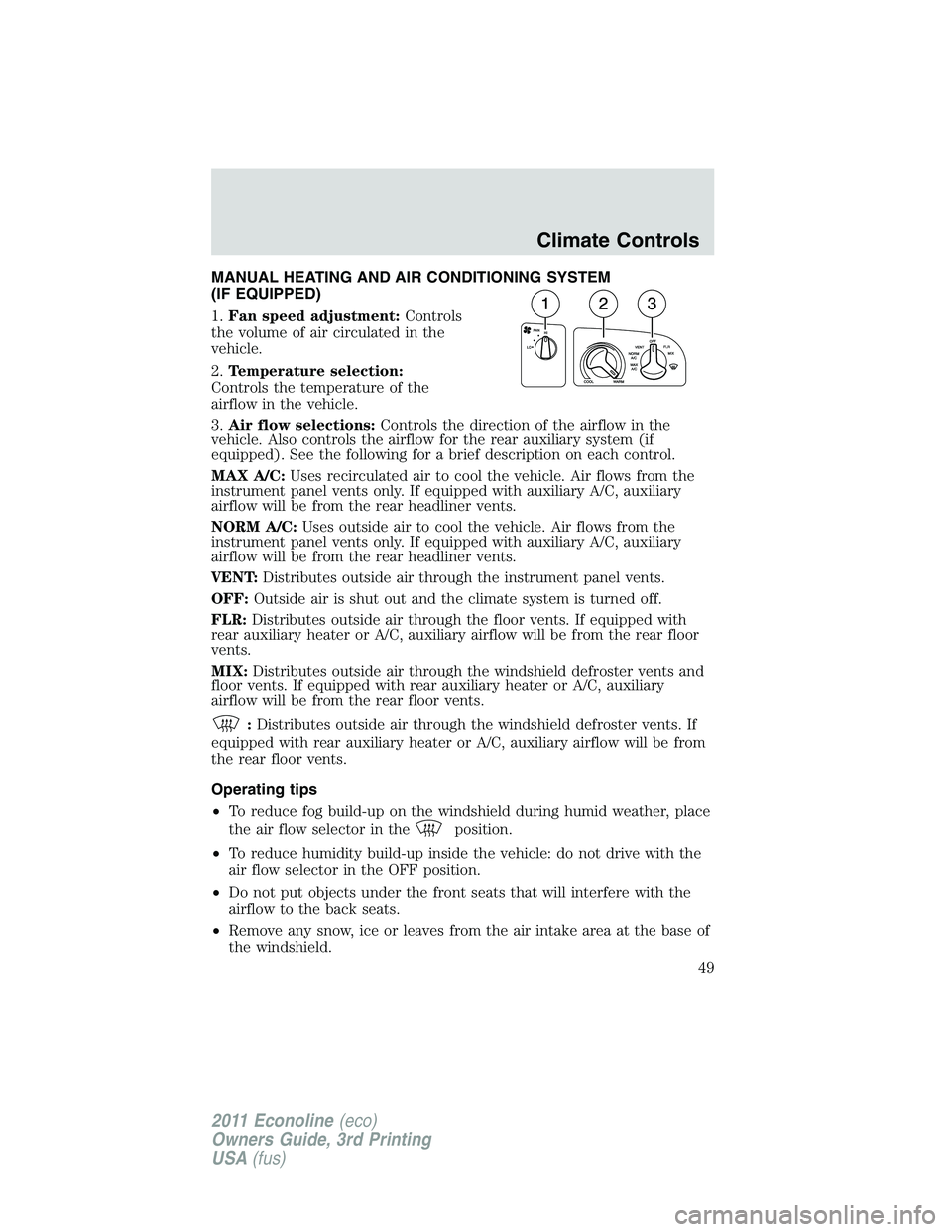
MANUAL HEATING AND AIR CONDITIONING SYSTEM
(IF EQUIPPED)
1.Fan speed adjustment:Controls
the volume of air circulated in the
vehicle.
2.Temperature selection:
Controls the temperature of the
airflow in the vehicle.
3.Air flow selections:Controls the direction of the airflow in the
vehicle. Also controls the airflow for the rear auxiliary system (if
equipped). See the following for a brief description on each control.
MAX A/C:Uses recirculated air to cool the vehicle. Air flows from the
instrument panel vents only. If equipped with auxiliary A/C, auxiliary
airflow will be from the rear headliner vents.
NORM A/C:Uses outside air to cool the vehicle. Air flows from the
instrument panel vents only. If equipped with auxiliary A/C, auxiliary
airflow will be from the rear headliner vents.
VENT:Distributes outside air through the instrument panel vents.
OFF:Outside air is shut out and the climate system is turned off.
FLR:Distributes outside air through the floor vents. If equipped with
rear auxiliary heater or A/C, auxiliary airflow will be from the rear floor
vents.
MIX:Distributes outside air through the windshield defroster vents and
floor vents. If equipped with rear auxiliary heater or A/C, auxiliary
airflow will be from the rear floor vents.
:Distributes outside air through the windshield defroster vents. If
equipped with rear auxiliary heater or A/C, auxiliary airflow will be from
the rear floor vents.
Operating tips
•To reduce fog build-up on the windshield during humid weather, place
the air flow selector in the
position.
•To reduce humidity build-up inside the vehicle: do not drive with the
air flow selector in the OFF position.
•Do not put objects under the front seats that will interfere with the
airflow to the back seats.
•Remove any snow, ice or leaves from the air intake area at the base of
the windshield.
Climate Controls
49
2011 Econoline(eco)
Owners Guide, 3rd Printing
USA(fus)
Page 86 of 339
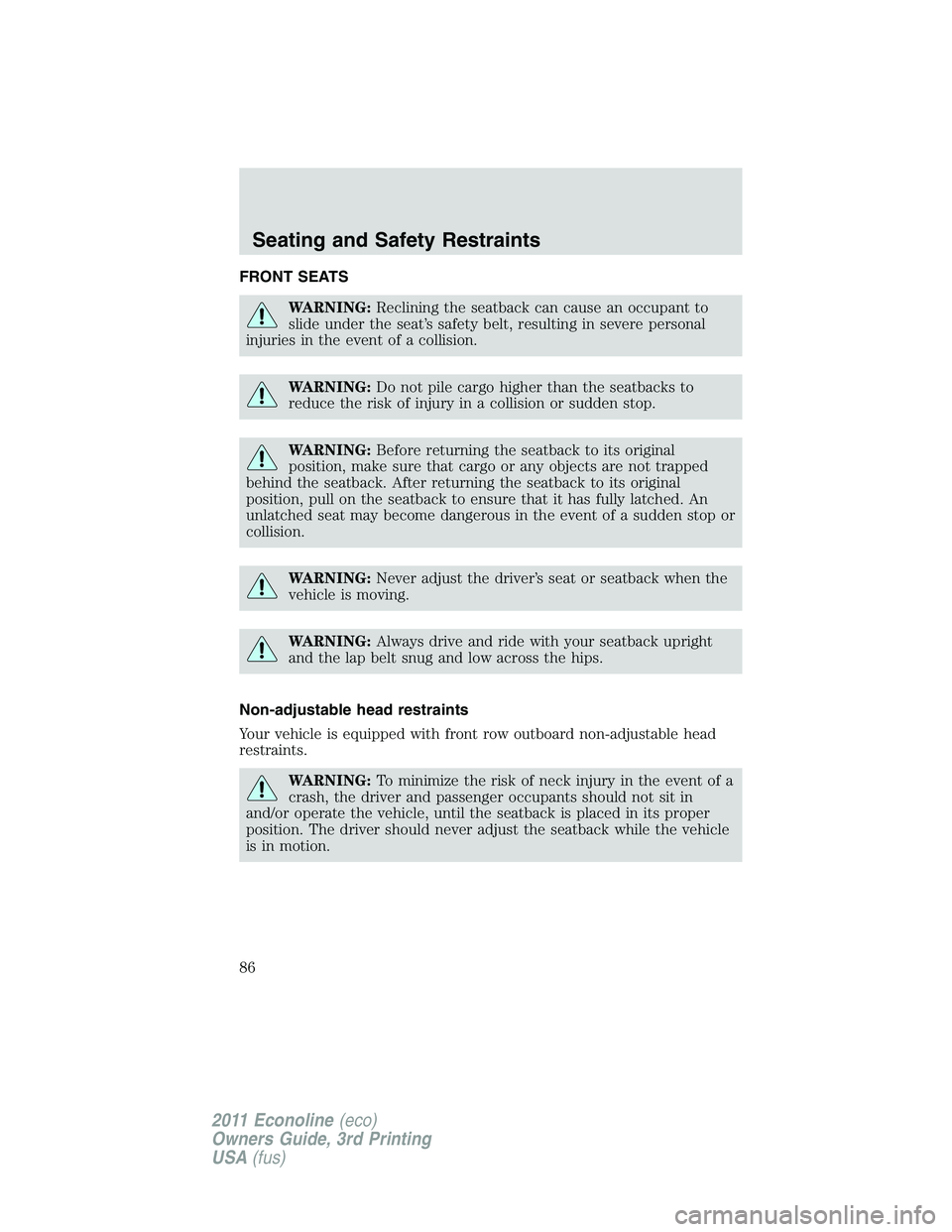
FRONT SEATS
WARNING:Reclining the seatback can cause an occupant to
slide under the seat’s safety belt, resulting in severe personal
injuries in the event of a collision.
WARNING:Do not pile cargo higher than the seatbacks to
reduce the risk of injury in a collision or sudden stop.
WARNING:Before returning the seatback to its original
position, make sure that cargo or any objects are not trapped
behind the seatback. After returning the seatback to its original
position, pull on the seatback to ensure that it has fully latched. An
unlatched seat may become dangerous in the event of a sudden stop or
collision.
WARNING:Never adjust the driver’s seat or seatback when the
vehicle is moving.
WARNING:Always drive and ride with your seatback upright
and the lap belt snug and low across the hips.
Non-adjustable head restraints
Your vehicle is equipped with front row outboard non-adjustable head
restraints.
WARNING:To minimize the risk of neck injury in the event of a
crash, the driver and passenger occupants should not sit in
and/or operate the vehicle, until the seatback is placed in its proper
position. The driver should never adjust the seatback while the vehicle
is in motion.
Seating and Safety Restraints
86
2011 Econoline(eco)
Owners Guide, 3rd Printing
USA(fus)
Page 89 of 339
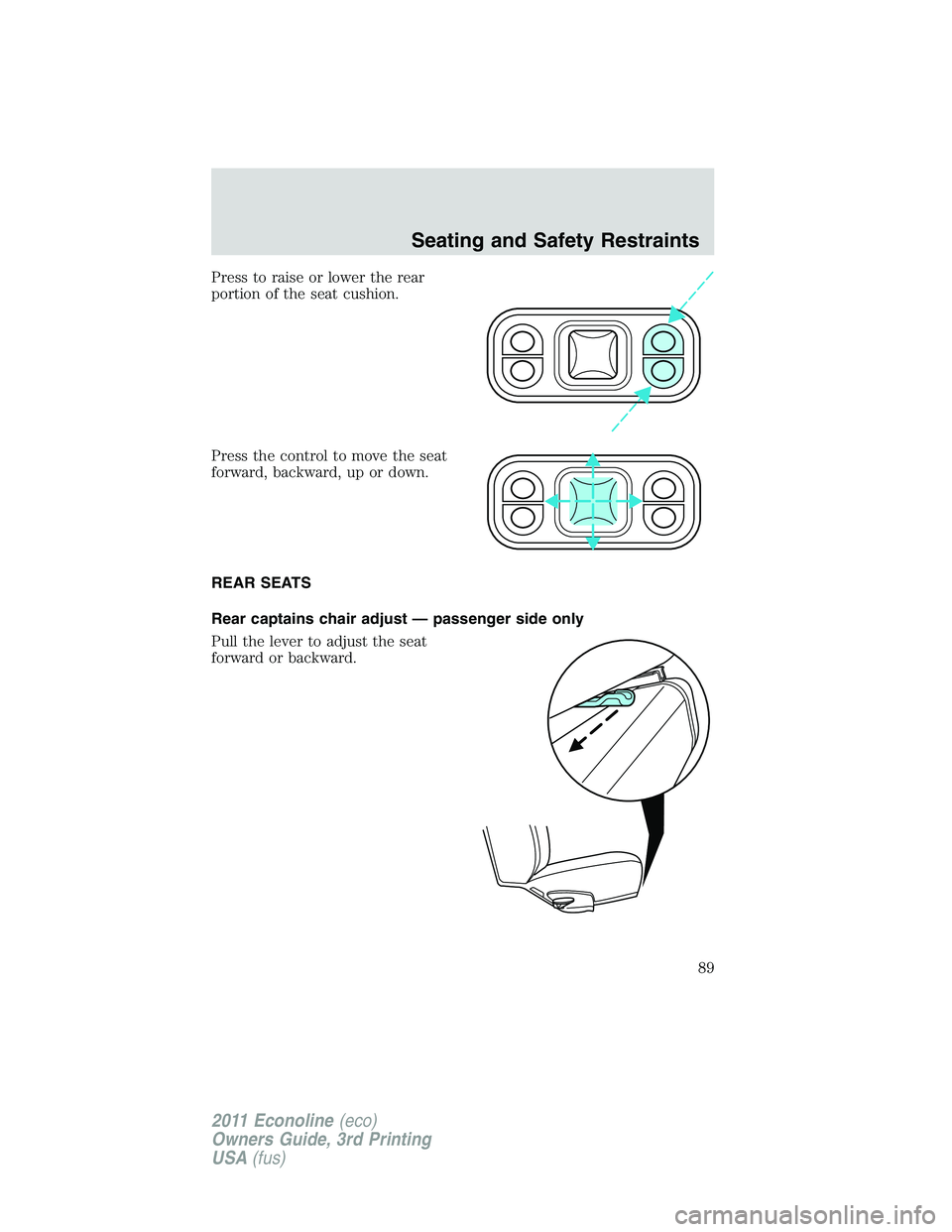
Press to raise or lower the rear
portion of the seat cushion.
Press the control to move the seat
forward, backward, up or down.
REAR SEATS
Rear captains chair adjust — passenger side only
Pull the lever to adjust the seat
forward or backward.
Seating and Safety Restraints
89
2011 Econoline(eco)
Owners Guide, 3rd Printing
USA(fus)
Page 91 of 339
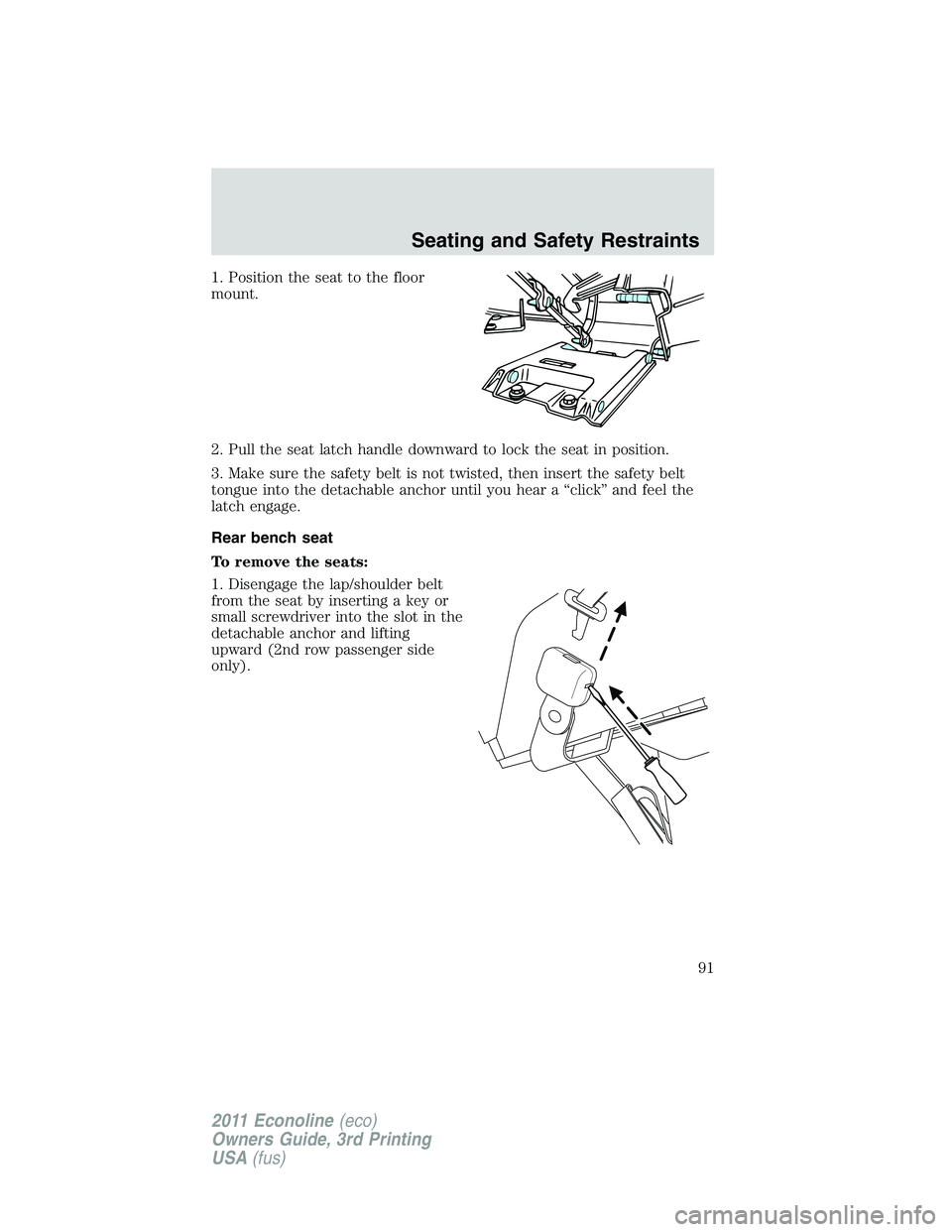
1. Position the seat to the floor
mount.
2. Pull the seat latch handle downward to lock the seat in position.
3. Make sure the safety belt is not twisted, then insert the safety belt
tongue into the detachable anchor until you hear a “click” and feel the
latch engage.
Rear bench seat
To remove the seats:
1. Disengage the lap/shoulder belt
from the seat by inserting a key or
small screwdriver into the slot in the
detachable anchor and lifting
upward (2nd row passenger side
only).
Seating and Safety Restraints
91
2011 Econoline(eco)
Owners Guide, 3rd Printing
USA(fus)
Page 93 of 339
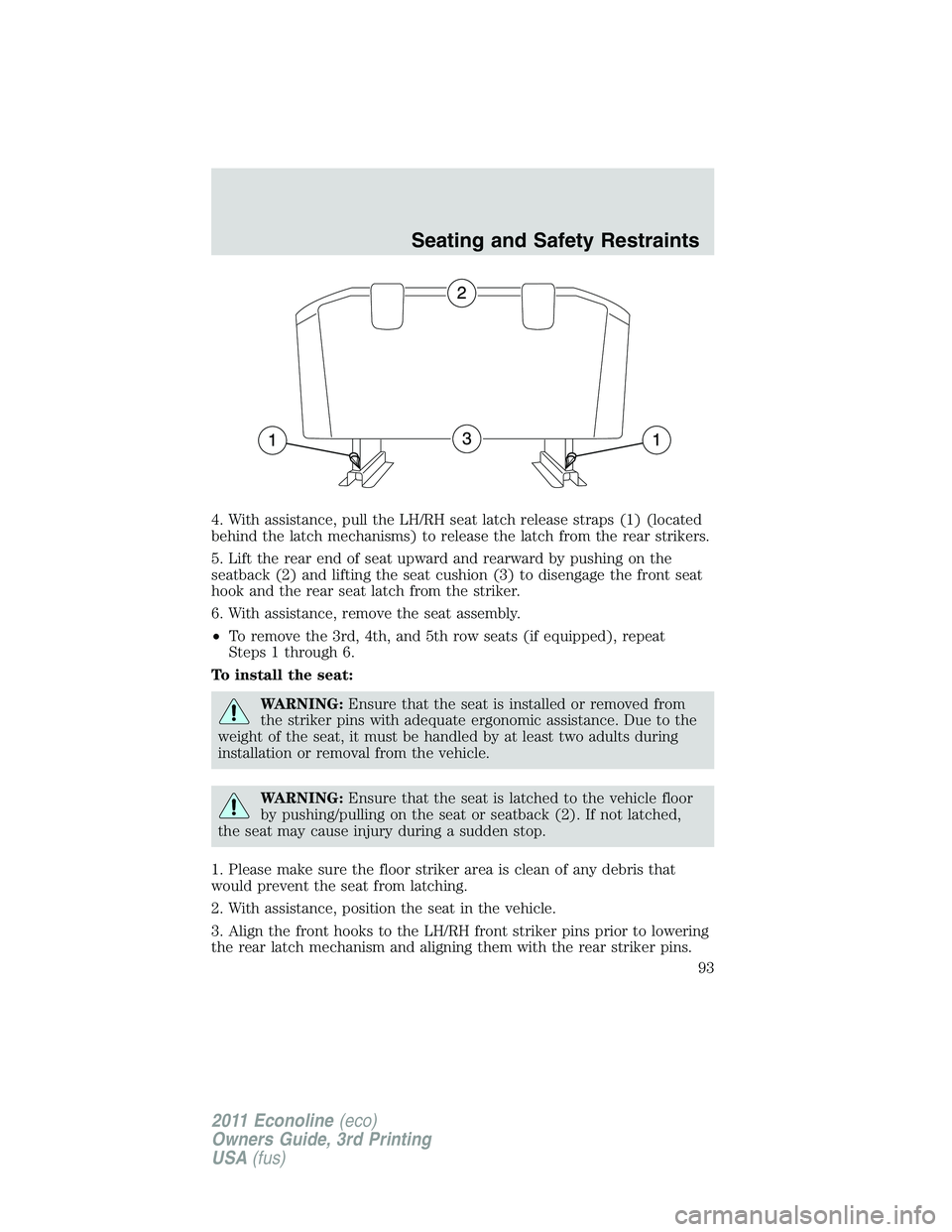
4. With assistance, pull the LH/RH seat latch release straps (1) (located
behind the latch mechanisms) to release the latch from the rear strikers.
5. Lift the rear end of seat upward and rearward by pushing on the
seatback (2) and lifting the seat cushion (3) to disengage the front seat
hook and the rear seat latch from the striker.
6. With assistance, remove the seat assembly.
•To remove the 3rd, 4th, and 5th row seats (if equipped), repeat
Steps 1 through 6.
To install the seat:
WARNING:Ensure that the seat is installed or removed from
the striker pins with adequate ergonomic assistance. Due to the
weight of the seat, it must be handled by at least two adults during
installation or removal from the vehicle.
WARNING:Ensure that the seat is latched to the vehicle floor
by pushing/pulling on the seat or seatback (2). If not latched,
the seat may cause injury during a sudden stop.
1. Please make sure the floor striker area is clean of any debris that
would prevent the seat from latching.
2. With assistance, position the seat in the vehicle.
3. Align the front hooks to the LH/RH front striker pins prior to lowering
the rear latch mechanism and aligning them with the rear striker pins.
Seating and Safety Restraints
93
2011 Econoline(eco)
Owners Guide, 3rd Printing
USA(fus)
Page 94 of 339
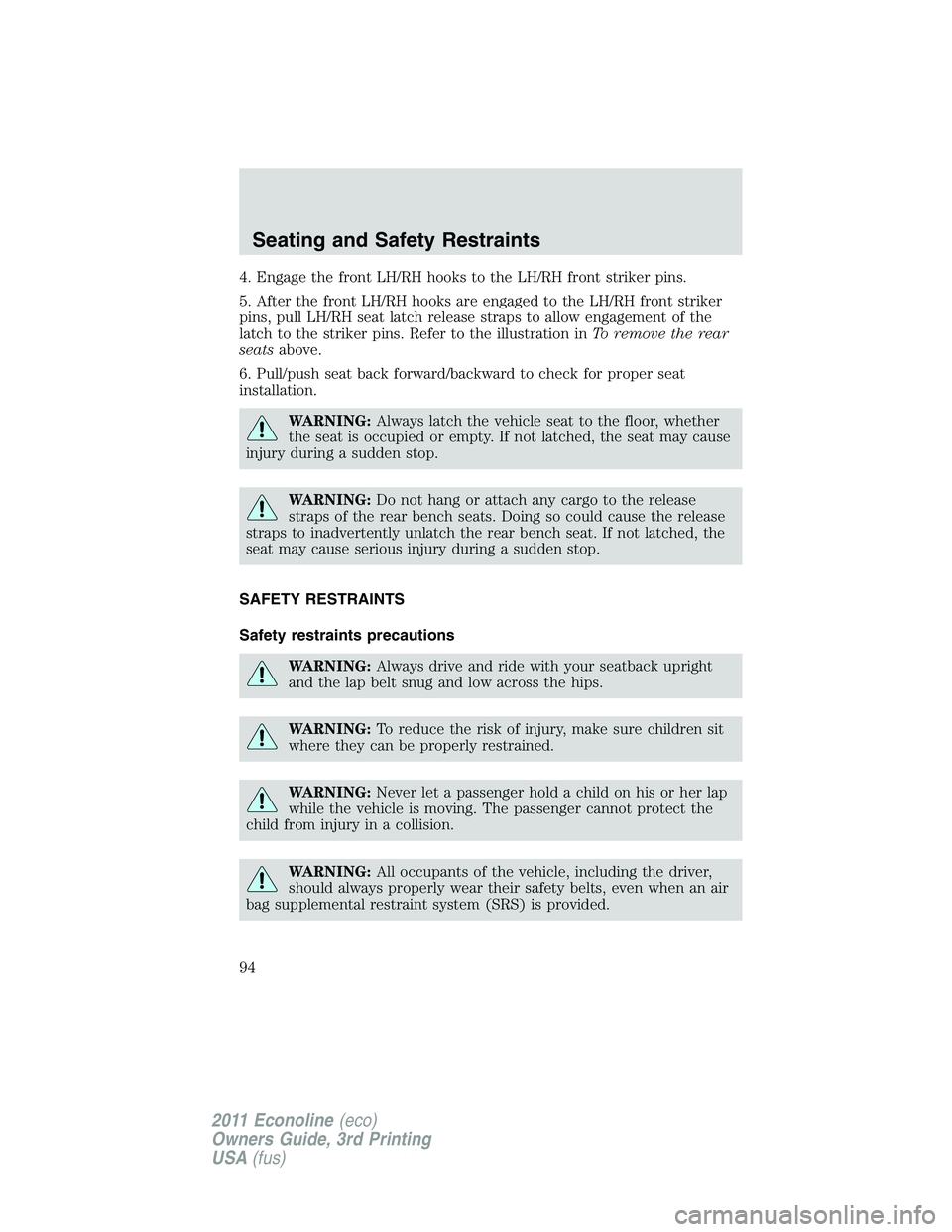
4. Engage the front LH/RH hooks to the LH/RH front striker pins.
5. After the front LH/RH hooks are engaged to the LH/RH front striker
pins, pull LH/RH seat latch release straps to allow engagement of the
latch to the striker pins. Refer to the illustration inTo remove the rear
seatsabove.
6. Pull/push seat back forward/backward to check for proper seat
installation.
WARNING:Always latch the vehicle seat to the floor, whether
the seat is occupied or empty. If not latched, the seat may cause
injury during a sudden stop.
WARNING:Do not hang or attach any cargo to the release
straps of the rear bench seats. Doing so could cause the release
straps to inadvertently unlatch the rear bench seat. If not latched, the
seat may cause serious injury during a sudden stop.
SAFETY RESTRAINTS
Safety restraints precautions
WARNING:Always drive and ride with your seatback upright
and the lap belt snug and low across the hips.
WARNING:To reduce the risk of injury, make sure children sit
where they can be properly restrained.
WARNING:Never let a passenger hold a child on his or her lap
while the vehicle is moving. The passenger cannot protect the
child from injury in a collision.
WARNING:All occupants of the vehicle, including the driver,
should always properly wear their safety belts, even when an air
bag supplemental restraint system (SRS) is provided.
Seating and Safety Restraints
94
2011 Econoline(eco)
Owners Guide, 3rd Printing
USA(fus)
Page 95 of 339
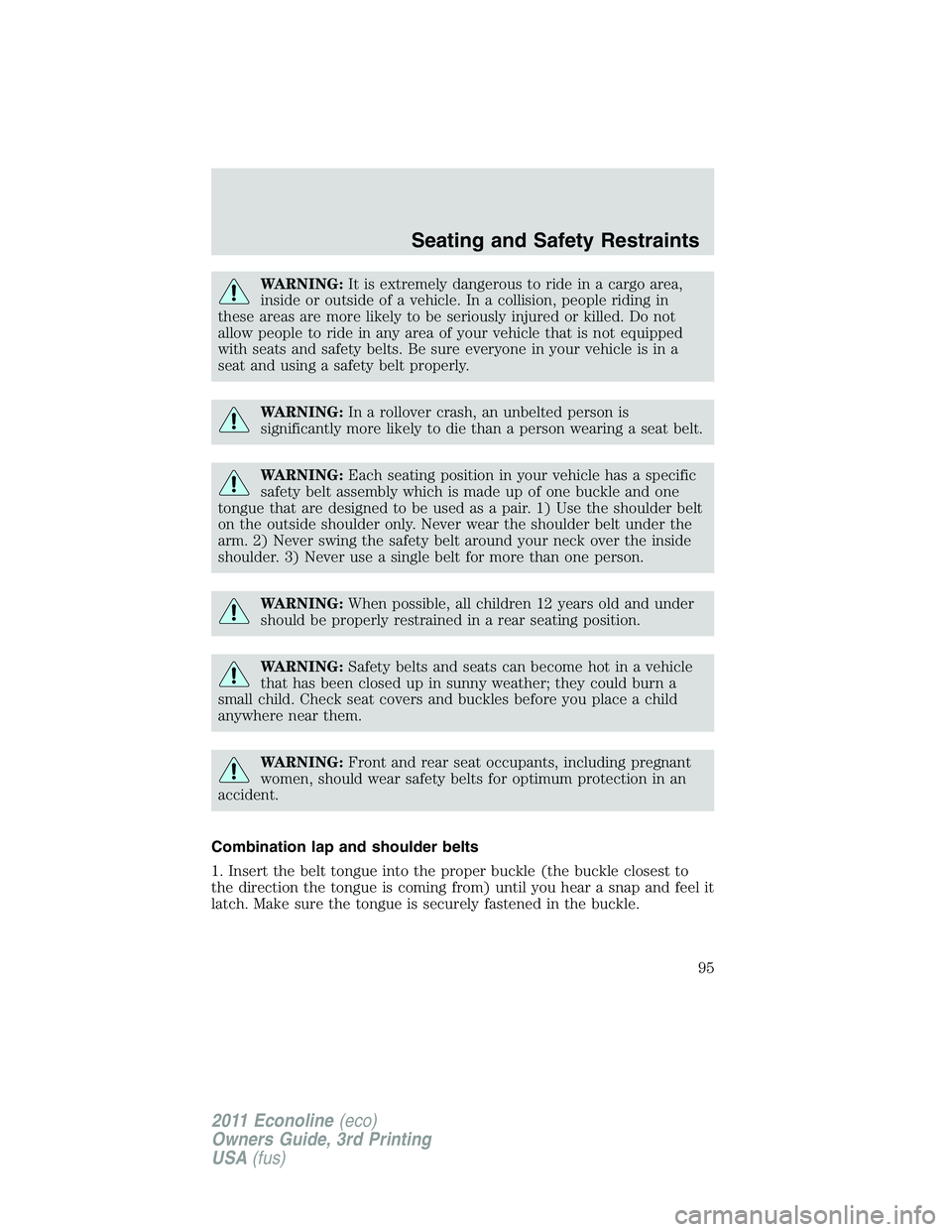
WARNING:It is extremely dangerous to ride in a cargo area,
inside or outside of a vehicle. In a collision, people riding in
these areas are more likely to be seriously injured or killed. Do not
allow people to ride in any area of your vehicle that is not equipped
with seats and safety belts. Be sure everyone in your vehicle is in a
seat and using a safety belt properly.
WARNING:In a rollover crash, an unbelted person is
significantly more likely to die than a person wearing a seat belt.
WARNING:Each seating position in your vehicle has a specific
safety belt assembly which is made up of one buckle and one
tongue that are designed to be used as a pair. 1) Use the shoulder belt
on the outside shoulder only. Never wear the shoulder belt under the
arm. 2) Never swing the safety belt around your neck over the inside
shoulder. 3) Never use a single belt for more than one person.
WARNING:When possible, all children 12 years old and under
should be properly restrained in a rear seating position.
WARNING:Safety belts and seats can become hot in a vehicle
that has been closed up in sunny weather; they could burn a
small child. Check seat covers and buckles before you place a child
anywhere near them.
WARNING:Front and rear seat occupants, including pregnant
women, should wear safety belts for optimum protection in an
accident.
Combination lap and shoulder belts
1. Insert the belt tongue into the proper buckle (the buckle closest to
the direction the tongue is coming from) until you hear a snap and feel it
latch. Make sure the tongue is securely fastened in the buckle.
Seating and Safety Restraints
95
2011 Econoline(eco)
Owners Guide, 3rd Printing
USA(fus)
Page 96 of 339
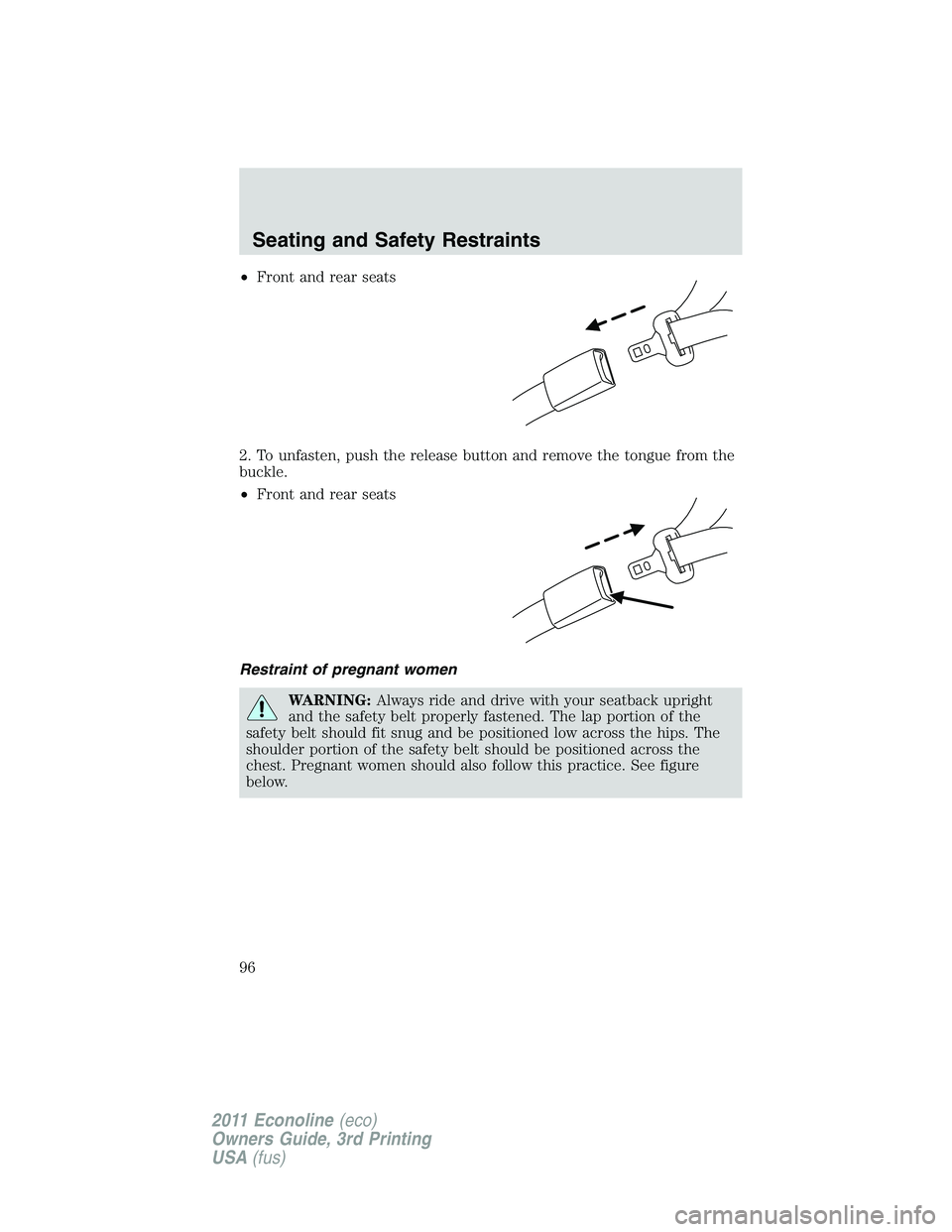
•Front and rear seats
2. To unfasten, push the release button and remove the tongue from the
buckle.
•Front and rear seats
Restraint of pregnant women
WARNING:Always ride and drive with your seatback upright
and the safety belt properly fastened. The lap portion of the
safety belt should fit snug and be positioned low across the hips. The
shoulder portion of the safety belt should be positioned across the
chest. Pregnant women should also follow this practice. See figure
below.
Seating and Safety Restraints
96
2011 Econoline(eco)
Owners Guide, 3rd Printing
USA(fus)